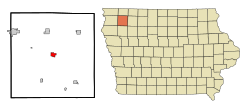Primghar, Iowa
Primghar, Iowa | |
|---|---|
 Location of Primghar, Iowa | |
| Country | |
| State | |
| County | O'Brien |
| Area | |
| • Total | 1.4 sq mi (3.6 km2) |
| • Land | 1.4 sq mi (3.6 km2) |
| • Water | 0.0 sq mi (0.0 km2) |
| Elevation | 1,526 ft (465 m) |
| Population (2000) | |
| • Total | 891 |
| • Density | 643.9/sq mi (248.6/km2) |
| Time zone | UTC-6 (Central (CST)) |
| • Summer (DST) | UTC-5 (CDT) |
| ZIP code | 51245 |
| Area code | 712 |
| FIPS code | 19-64650 |
| GNIS feature ID | 0460449 |
Primghar is a city in and the county seat of O'Brien County, Iowa, United States, United States.Template:GR7 The population was 891 at the 2000 census.
History
In a brief history of O'Brien County, Arthur M. Schierholz states: "the courthouse location in (the village of) O'Brien in the extreme southeast corner of the county became a growing issue. To resolve the matter, an election was held on November 11, 1872, to determine the location of the courthouse. A total of 360 votes were cast with 307 voting to move the court house to the exact geographical center of the county. One historian wrote, "Probably the only case in Iowa, perhaps anywhere, where a bare spot of raw prairie was actually voted to be the county seat." This eventually became the town of Primghar."
Geography
Primghar is located at 43°5′16″N 95°37′40″W / 43.08778°N 95.62778°WInvalid arguments have been passed to the {{#coordinates:}} function (43.087722, -95.627892)Template:GR.
According to the United States Census Bureau, the city has a total area of 1.4 square miles (3.6 km²), all of it land.
Topography
Elevation is 1520 feet. This area of northwest Iowa is gently rolling. Today fields are marred by few boggy areas and much of the land is terraced to reduce erosion. Until fill was hauled in, the south side of the courthouse square was a "boggy, muddy slough." When the first settlers arrived there were few trees and almost without exception prairie grass grew to six foot.
In the immediate vicinity of Primghar the topsoils and subsoils are silty clay loam. (Galva, Marcus, Primghar, and Sac soils by name.) Clay loam glacial till is at a depth of 30 to 60 inches in most places. There are no mineral assets of commercial value save rock and gravel. Back in 1873 this dearth of underground wealth was yet to be decided. There was a $1000 reward posted for anyone finding mineable coal reserves. No one claimed the prize.
There is an abandoned rock quarry a mile SSE of Primghar which was donated by the Tjossem family to Primghar in 1989 and is now known as Tjossem Park, a fishing area and public picnic/camp ground.
Demographics
As of the censusTemplate:GR of 2000, there were 891 people, 391 households, and 233 families residing in the city. The population density was 643.9 people per square mile (249.3/km²). There were 437 housing units at an average density of 315.8/sq mi (122.3/km²). The racial makeup of the city was 98.20% White, 0.11% Native American, 1.12% Asian, 0.11% from other races, and 0.45% from two or more races. Hispanic or Latino of any race were 0.79% of the population.
There were 391 households out of which 26.1% had children under the age of 18 living with them, 51.4% were married couples living together, 5.4% had a female householder with no husband present, and 40.4% were non-families. 36.6% of all households were made up of individuals and 24.6% had someone living alone who was 65 years of age or older. The average household size was 2.17 and the average family size was 2.86.
In the city the population was spread out with 21.5% under the age of 18, 6.5% from 18 to 24, 21.7% from 25 to 44, 21.9% from 45 to 64, and 28.4% who were 65 years of age or older. The median age was 45 years. For every 100 females there were 89.2 males. For every 100 females age 18 and over, there were 82.5 males.
The median income for a household in the city was $31,304, and the median income for a family was $40,982. Males had a median income of $30,134 versus $20,694 for females. The per capita income for the city was $17,791. About 5.2% of families and 9.6% of the population were below the poverty line, including 9.8% of those under age 18 and 6.7% of those age 65 or over.
References

